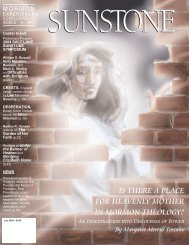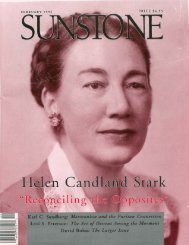Download Entire Issue PDF - Sunstone Magazine
Download Entire Issue PDF - Sunstone Magazine
Download Entire Issue PDF - Sunstone Magazine
You also want an ePaper? Increase the reach of your titles
YUMPU automatically turns print PDFs into web optimized ePapers that Google loves.
S U N S T O N E<br />
the Mormons in Ohio Between 1830 and 1838,” esp. 309–17; Davis Bitton,<br />
“The Waning of Mormon Kirtland,” BYU Studies 12 (Summer 1972): 455–64;<br />
Marvin S. Hill, “Cultural Crisis in the Mormon Kingdom: A Reconsideration of<br />
the Causes of Kirtland Dissent,” Church History 49 (September 1980): 286–97;<br />
Milton V. Backman Jr., The Heavens Resound: A History of the Latter-day Saints in<br />
Ohio, 1830–1838 (Salt Lake City: Deseret Book Co., 1983), 310–41; Karl Ricks<br />
Anderson, Joseph Smith’s Kirtland: Eyewitness Accounts (Salt Lake City: Deseret<br />
Book Co., 1989), 193–223; Church History in the Fulness of Times, 169–80;<br />
Kenneth H. Winn, Exiles in a Land of Liberty: Mormons in America, 1830–1846<br />
(Chapel Hill: University of North Carolina Press, 1989), 106–28; Hill, Quest For<br />
Refuge, 55–80; Milton V. Backman Jr. and Ronald K. Esplin, “History of the<br />
Church: 1831–1844,” and Backman, “Kirtland,” in Ludlow, Encyclopedia of<br />
Mormonism, 2: 609–10, 797; Allen and Leonard, Story of the Latter-day Saints,<br />
117–25; Origins of Power, 61–62.<br />
64. Hill, Quest for Refuge, 70. In view of that assessment by Marvin S. Hill in<br />
1989, I was mystified by his rejection in SUNSTONE (November 1997) of my<br />
analysis of early Mormonism’s culture of violence as presented in Extensions of<br />
Power.<br />
65. Francis M. Gibbons, Joseph Smith: Martyr, Prophet of God (Salt Lake<br />
City: Deseret Book Co., 1977), 228–29; Leonard J. Arrington, Brigham Young:<br />
American Moses (New York: Alfred A. Knopf, 1985), 65. Hill, Joseph Smith, gave<br />
the traditional account (223–24) that Smith was unaware of the Danites and<br />
quickly repudiated them, but she concluded (225) that he had at least peripheral<br />
involvement with the Danites and gave approval of their early activities.<br />
66. William Swartzell (a Danite) daily journal, 14 July 1838, in his<br />
Mormonism Exposed, Being a Journal of a Residence in Missouri From the 28th of<br />
May to the 20th of August, 1838 (Pekin, OH: A. Ingram Jr., Printer, 1840), 18.<br />
67. Dean C. Jessee and David J. Whittaker, “The Last Months of<br />
Mormonism in Missouri: The Albert Perry Rockwood Journal,” BYU Studies 28<br />
(Winter 1988): 23, as a slightly different version of Albert P. Rockwood to<br />
Luther Rockwood, 29 October 1838 (rather than 22 October, as in Jesse and<br />
Whittaker), Beinecke Library.<br />
Nevertheless, as I discuss in Origins of Power, 111, until 1842, early<br />
Mormon pamphleteering and editorials did not discuss the Daniel prophecies<br />
as applying to the LDS Church at present, but instead discussed theocracy as a<br />
distant, millennial circumstance. Joseph Smith changed the emphasis both<br />
publicly and privately in 1842, thus introducing the Missouri Danite interpretation<br />
to the Church at large.<br />
68. John Smith diary, 4 August, 1 September 1838, George A. Smith Family<br />
papers, Manuscripts Division, Special Collections, J. Willard Marriott Library,<br />
University of Utah, Salt Lake City, Utah; John E. Thompson, “A Chronology of<br />
Danite Meetings in Adam-ondi-Ahman, Missouri, July to September, 1838,”<br />
Restoration: News, Views, and History of the Latter Day Saint Movement 4<br />
(January 1985): 11–14; Stephen C. LeSueur, The 1838 Mormon War in Missouri<br />
(Columbia: University of Missouri Press, 1987), 38, 44.<br />
Richard Lloyd Anderson, “Clarifications of Bogg’s [sic] `Order’ and Joseph<br />
Smith’s Constitutionalism,” in Arnold K. Garr and Clark V. Johnson, eds.,<br />
Regional Studies in Latter-day Saint Church History: Missouri (Provo, UT:<br />
Department of Church History and Doctrine, Brigham Young University, 1994),<br />
64, claimed that the “only official and contemporary” reference by LDS leaders<br />
to the Danites was a statement by George W. Robinson (“a Danite officer and<br />
Church recorder”) in Joseph Smith’s “Scriptory Book” (Anderson, 71n19,<br />
80n147).<br />
However, Anderson nowhere acknowledges that John Smith, an assistant<br />
counselor in the First Presidency and the prophet’s uncle, made repeated references<br />
of a positive or neutral nature to the Danites in his 1838 diary. This diary’s<br />
quotes about the Danites and “the Daughters of Zion” appeared on page 44 of<br />
LeSueur, The 1838 Mormon War, which Anderson’s article was trying to refute.<br />
By linking “official” and “contemporary,” Anderson was able to legalistically exclude<br />
most of the first-hand Danite evidence he didn’t like. However, since he<br />
included the private diary of the LDS president, even Richard L. Anderson’s<br />
own rules of evidence should have required him to include the Danite references<br />
written in 1838 by the First Presidency’s assistant counselor, who was<br />
also serving as a stake president in Missouri.<br />
69. Joseph Smith diary, 27 July 1838, in Faulring, An American Prophet’s<br />
Record, 35; Jessee, Papers of Joseph Smith, 2: 262; Jessee, Ashurst-McGee, and<br />
Jensen, Joseph Smith Papers: Journals, Volume 1: 1832–1839, 293. This entry did<br />
not make it into the official History of the Church.<br />
70. Times and Seasons 4 (15 July 1843): 271.<br />
71. Ebenezer Robinson, “Items of Personal History of the Editor,” The<br />
Return 2 (February 1890): 217. Hartley, My Best For the Kingdom, 47, also observed:<br />
“Evidence indicates that President Rigdon knew about them and gave<br />
them his blessing.”<br />
72. Anson Call statement to B.H. Roberts (an LDS general authority serving<br />
in the First Council of the Seventy) and John M. Whitaker (the Council’s secretary),<br />
30 December 1885, typescript, 1, Whitaker file, Utah State Historical<br />
Society, Salt Lake City, Utah; Corrill, Brief History, 30; Hartley, My Best For the<br />
Kingdom, 46; John E. Thompson, “The Far West Dissenters and the Gamblers<br />
at Vicksburg: An Examination of the Documentary Evidence and Historical<br />
Context of Sidney Rigdon’s Salt Sermon,” Restoration 5 (January 1986): 21–27.<br />
73. Document Containing the Correspondence, Orders, &c In Relation to the<br />
Disturbances With the Mormons, 103–07.<br />
74. Ebenezer Robinson, “Items of Personal History of the Editor,” The<br />
Return 1 (October 1889): 145–47, 2 (February 1890): 218–19.<br />
75. Avard testimony in Document Containing the Correspondence, Orders, &c<br />
In Relation to the Disturbances With the Mormons, 102. Leland H. Gentry, “The<br />
Danite Band of 1838,” BYU Studies 14 (Summer 1974): 424n14, acknowledged<br />
Avard’s testimony, but noted that since Rigdon did not sign the ultimatum, “it is<br />
possible, therefore, that Avard drew up the document himself.” Likewise,<br />
Church History in the Fulness of Times, 191, described this as “an unauthorized<br />
document . . . signed by eighty-four Church members, and it pointedly<br />
ordered the apostates to leave the county or face serious consequences.”<br />
However, “unauthorized” hardly fits a document which was signed by an assistant<br />
counselor in the First Presidency and by Second Counselor Hyrum Smith,<br />
brother of the Church President. Gentry did not list any of the signers except<br />
Avard, but suggested (425): “It is possible that the document was . . . presented<br />
for signing at one or more Danite meetings.”<br />
76. Some have viewed the Danite organization as formed in June 1838 for<br />
the sole purpose of opposing a handful of LDS dissenters, whose intimidation<br />
was unquestionably its first action. Although its blood-oath enforced internal<br />
loyalty, its constitution provided for military titles, structure, and chain-ofcommand.<br />
This indicates that large-scale military activities were paramount for<br />
its intended use from the very beginning of the Danite organization, not an afterthought<br />
following the expulsion of the dissenters. For the Danite constitution,<br />
see Document Containing the Correspondence, Orders, &c In Relation to the<br />
Disturbances With the Mormons, 102.<br />
77. Joseph Smith diary, 27 July 1838, in Jessee, Papers of Joseph Smith, 2:<br />
262; with differences in the printed transcriptions of Faulring, An American<br />
Prophet’s Record, 187, and of Jessee, Ashurst-McGee, and Jensen, Joseph Smith<br />
Papers: Journals, Volume 1: 1832–1839, 293. This entry did not make it into the<br />
official History of the Church.<br />
78. Joseph Smith diary, 4 July 1838, in Jessee, Papers of Joseph Smith, 2: 249<br />
(for quote), 249n1 (noting that “`June’ [was] penciled sideways in the margin<br />
opposite these lines,” which were otherwise dated as 4 July 1838; also Faulring,<br />
An American Prophet’s Record, 187; Jessee, Ashurst-McGee, and Jensen, Joseph<br />
Smith Papers: Journals, Volume 1: 1832–1839, 278; Hartley, My Best For the<br />
Kingdom, 46. This entry did not make it into the official History of the Church.<br />
79. McKiernan and Launius, The Book of John Whitmer, 165.<br />
80. LeSueur, The 1838 Mormon War in Missouri, 46. In confirmation of just<br />
how mainstream one LDS apologist regards this 1838 death threat against<br />
Mormon dissenters, Anderson, “Clarifications of Bogg’s [sic] `Order’ and Joseph<br />
Smith’s Constitutionalism,” 63, stated: “Like many responsible contemporaries,<br />
Joseph Smith experimented with prior restraint of defamation in times of<br />
danger. But the flight of the Cowdery-Whitmer group is an exception in Joseph<br />
Smith’s policy of full rights for Mormons and neighbors.”<br />
81. Leland H. Gentry, “A History of the Latter-day Saints In Northern<br />
Missouri From 1836 to 1839,” Ph.D. dissertation, Brigham Young University,<br />
1965, 171. However, despite the Mormon paranoia of 1838, the following is an<br />
overstatement by Winn, Exiles in a Land of Liberty, 126: “The banishment of the<br />
dissenters initiated a veritable reign of terror against those who might doubt the<br />
wisdom of Church policy.”<br />
82. Orson Hyde letter, 21 October 1844, in LDS newspaper Nauvoo<br />
Neighbor (edited by Apostle John Taylor in Nauvoo, IL), 4 December 1844.<br />
Although LDS headquarters intended Hyde’s letter to attack the character of<br />
Rigdon, who had been recently excommunicated for opposing the 1844 succession<br />
claims of the Quorum of the Twelve Apostles, Hyde’s letter also verified the<br />
First Presidency’s 1838 authorization of theocratic killings.<br />
83. Benjamin Slade testimony (November 1838) about Rigdon’s statement<br />
the previous month, in Document Containing the Correspondence, Orders, &c In<br />
Relation to the Disturbances With the Mormons, 143. For Slade as a loyal<br />
Mormon in Nauvoo and Utah, see his entry in Susan Ward Easton Black,<br />
Membership of The Church of Jesus Christ of Latter-day Saints, 1830–1848, 50<br />
OCTOBER 2011 PAGE 33

















